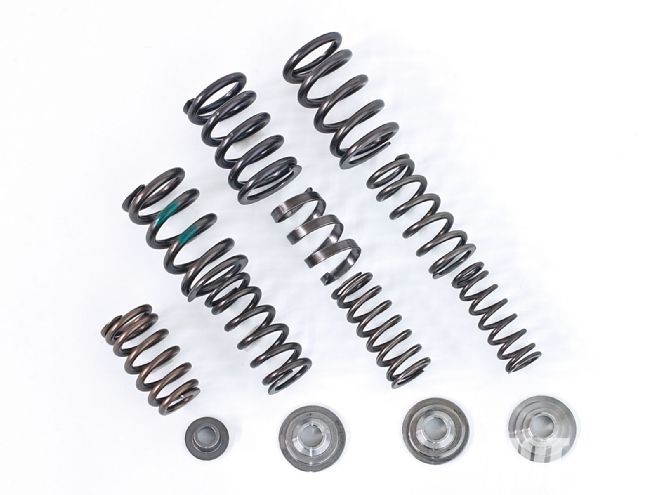
For many years camshaft technology was limited not by any lack of knowledge on the part of lobe profilers but by valvespring technology that just wasn't up to stabilizing aggressive lobe designs. But within the last 10 years, spring material and design improvements have evolved that-in conjunction with ever-lighter valvetrains-enable the potential of modern cam lobe profiles and high-flowing cylinder heads to be fully realized. Today, we have more spring choices than ever, but that also means it's easier to go down the wrong path or to very quickly get confused on all the intricacies of installing and setting up valvesprings. To answer the most basic but often misunderstood questions about valvesprings, HOT ROD consulted with a variety of experts, including Billy Godbold (Comp Cams), Joe Sherman (Joe Sherman Racing), Judson Massingill (School of Automotive Machinists/SAM), Ken Crocie (H-O Enterprises), Ken Duttweiler (Duttweiler Performance), and Steve Brulé (Westech Performance).
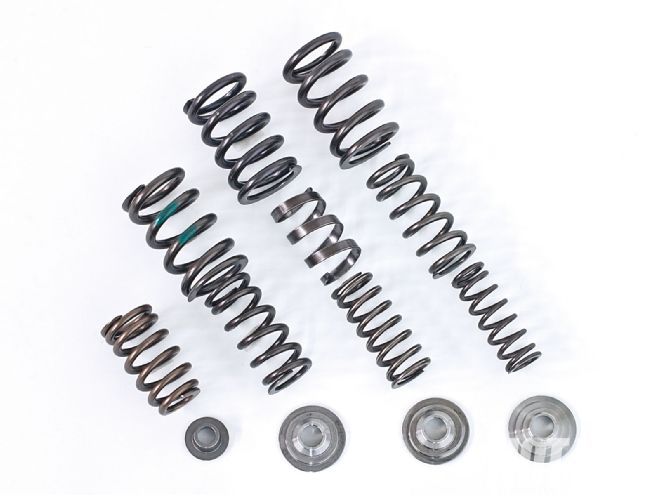 Typical springs and re-tainers used in current high-performance and racing engines include (from left) a modern single beehive spring, a dual spring, a dual spring with damper, and a triple spring. Duals with dampers are on their way out. The preferred solution is a dual in which the inner spring retains some damper-like properties due to its tight interference fit.
Typical springs and re-tainers used in current high-performance and racing engines include (from left) a modern single beehive spring, a dual spring, a dual spring with damper, and a triple spring. Duals with dampers are on their way out. The preferred solution is a dual in which the inner spring retains some damper-like properties due to its tight interference fit.
New Tech, New Thinking
As applied to high-performance work, the valvespring's principal function is preventing valve float, defined by Godbold as "the limit speed of the valve where the spring is no longer controlling motion." The more radical the cam, the more spring you need. Traditionally, spring engineers made stiffer springs by using better materials, increasing the number of coils, and/or increasing the size of the coils. As cams became more aggressive, springs got larger, heavier, and had more elements added: Duals replaced singles, triples replaced duals. Eventually this became counterproductive because a significant portion of the big spring's higher pressure was wasted trying to control its own weight.
In the last 10 years, new materials and configurations have been developed that allow smaller springs to control the valve with larger cams. Even on the high end, the new-gen doubles can often replace triples. As Duttweiler puts it, "An inner spring on a traditional triple assembly adds a good portion of its weight to the spring mass-as much as 40 grams more. We often remove the inner on a triple and don't lose anything."
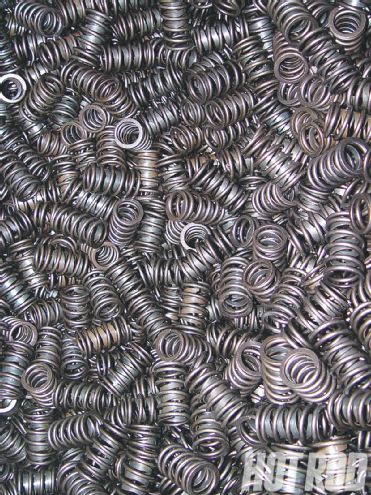 Even the world's baddest cam is no better than the valvesprings needed to control its motion at the valve. Valvespring selection can make or break your engine.
Even the world's baddest cam is no better than the valvesprings needed to control its motion at the valve. Valvespring selection can make or break your engine.
New wire shapes and configurations have also changed spring selection. Coil spring wire used to be round; now (although more costly), some springs use ovate (oval-shaped) wire. An ovate wire gives you more spring in a given amount of space, which means that at the same installed height, an ovate wire can handle more lift than an old-school round-wire spring before stacking solid.
Some new springs no longer retain a constant top to bottom diameter. Of particular interest to street high-performance and entry-level street/strip bracket racers, the beehive spring has a narrow top, expanding to a wider bottom. This type of spring is used in many new production engines and is now available for older engines, too. They save significant weight over constant-diameter springs for an equivalent application: The spring itself is lighter, plus its small-diameter top permits a very small and lightweight retainer without going to exotic retainer materials. Depending on whom you talk to, on the top end, the beehive's mass reduction is worth anywhere from 200 rpm to (on a hydraulic roller-cammed big-block Chevy) as much as 1,000 rpm.
Right now, beehives are only offered in a single-spring configuration, so they can't support a huge solid roller cam. And some traditionalists still prefer a dual spring's perceived reliability advantage: If one spring on a dual breaks, the remaining spring may prevent valve drop long enough to shut down the engine before catastrophic failure occurs. Still, the beehives are often worth power (see sidebar), and real-world experience indicates they're less likely to fail than conventional springs because the beehive configuration reduces negative spring harmonics. In the same vein, the classic dual spring with damper configuration is giving way to a dual spring in which the two elements have an interference fit. The damper was thought necessary to avoid the bad vibes, but it adds mass and sometimes has reliability issues. The interference fit provides the necessary damping function while also saving mass, which itself improves harmonics.
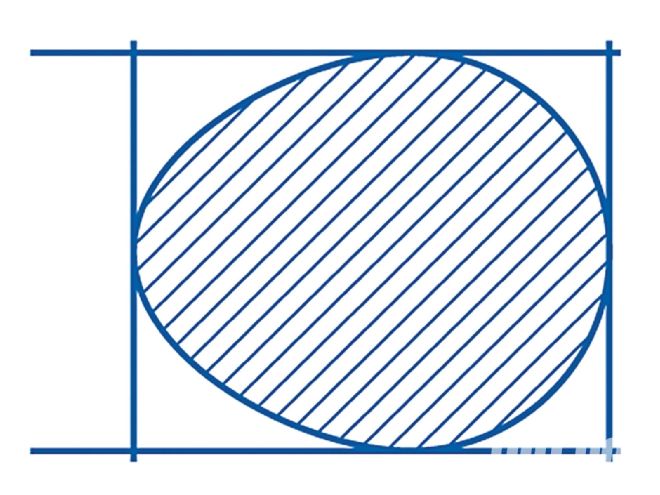 Ovate springs are made using oval-shaped wire. They have more material occupying the same area compared with a conventional round-wire spring. This more efficiently distributes operational stresses and allows better heat dissipation for longer life. Ovate wire can be used to make conventional and beehive springs.
Ovate springs are made using oval-shaped wire. They have more material occupying the same area compared with a conventional round-wire spring. This more efficiently distributes operational stresses and allows better heat dissipation for longer life. Ovate wire can be used to make conventional and beehive springs.
Spring Selection
One of the biggest questions about valvesprings is if it's OK to use generic springs and valvetrain parts or if the cam, springs, and other critical valvetrain parts must be sourced as an integrated package from the same manufacturer. There's no pat answer. Many aftermarket heads come assembled with generic springs for a particular cam type (flat tappet, hydraulic roller [HR], or solid roller) and usually perform fine for the average hot rodder. On the other hand, there's always performance to be had by paying attention to every detail. Obviously, the higher the intended rpm operating range and/or the bigger the cam, the more critical this stuff becomes. You probably need to take a closer look if you will routinely run 7,000 rpm or higher and/or run cams with 240 degrees or more duration (at 0.050-inch tappet lift).
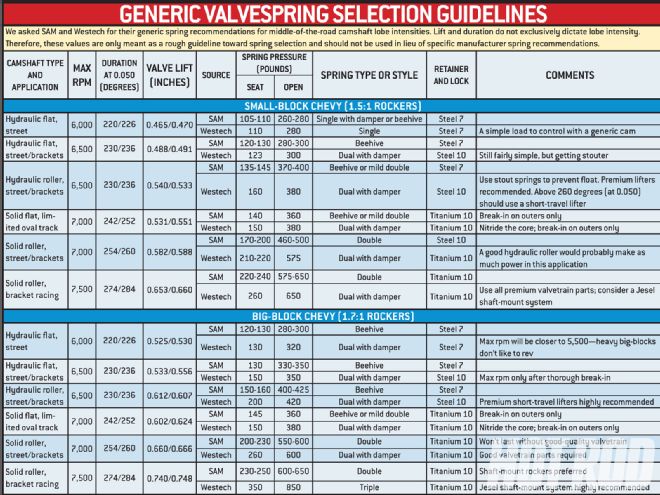
Also controversial is spring selection for hydraulic roller cams. Originally, aftermarket HR lifters were based on OEM technology. Although they were more intense than the stock grinds, specialty cam grinders still specified relatively soft springs to preserve 100,000-mile longevity with the OE-based lifters. That often resulted in premature valve float that prevented the new grinds from realizing their full potential. Running stouter springs cures the problem on the dyno but may reduce ultimate longevity. Today, new lightweight and short-travel HR lifters are available from aftermarket sources as well as on high-end OEM applications that greatly reduce the need for compromise.
High-end professional engine builders pushing the envelope may go directly to specialty spring manufacturers to obtain the absolute latest in spring technology, but for more normalized applications, we polled SAM and Westech for spring pressure recommendations on typical street and mild competition combinations (see table).
As shown in the table, springs are traditionally spec'd by their closed and open pressures. The closed (or seat) pressure (in psi) is established at a specified installed height. The open pressure is the pressure at the spring's specified compressed length, which may or may not equal the actual valve lift on your engine: [Installed height - (cam lobe lift × rocker arm ratio) + lash]. See the sidebar to determine how pressures change if your installed and open heights are different from published specs used to rate the spring. If you have to compromise, the current thinking is that open pressure is more critical.
Remembering that with the new spring technologies and configurations, pressures are not the be-all, end-all of spring selection, the table should still get you in the ballpark, at least providing a red flag that the springs included with your new heads or cam may not be suitable for the application if they fall widely outside the listed ranges.
The table is split into generic small- and big-block Chevy sections to illustrate a salient point in valvespring recommendations: The right spring for a similar application may vary according to the specific engine design. Chevy big-blocks have heavy canted valves with less than optimum valvetrain geometry, so they need much stouter springs than an equivalently cammed small-block.
The big Chevy also has a higher stock rocker arm ratio than a small-block (1.7:1 versus 1.5:1). The more severe the rocker arm, the more spring is needed to control it-yet another reason for the Rat's stouter springs. But the concept is also relevant to any engine in which you increase the ratio. On a typical small-block Chevy, you may lose 300 to 400 rpm on the top end for every 0.1 change in ratio if spring pressures remain the same as before. If, for example, you increased the small Chevy's rocker arm ratio from 1.5:1 to 1.6:1, that's a 6.7 percent ratio increase. To maintain the original rpm capability, Sherman says you would need to correspondingly increase open spring pressure by 6.7 percent. In other words, if your springs generated 400 pounds of open pressure at max cam lift with 1.5:1 rockers, the 1.6:1 ratio would need springs that generate 427 psi (400 × 1.067 = 427) at the spring's new open height.
Installation Issues The big Chevy may need a big spring, but it has plenty of room for them, even with factory heads-which brings us to the next thing we need to consider when choosing springs: whether they fit the heads. The spring's outer diameter must fit in the spring pocket, its inner diameter must clear the valve seal, its installed height must be sufficient to develop the required seat and open pressures, it must not go into coil bind (stack solid), and the retainer must not hit the valveguide or seal.
To reduce mass and enhance stability, a taller, smaller-diameter spring is preferred over an equivalent shorter, fatter spring. The governing theory is that it's always better to be taller than fatter because that keeps mass for a given spring rate lower. This makes installed height the most important limiting factor. As Massingill puts it, "You must measure your installed height and then find the spring that will have the correct seat and open pressure at that height. Some production heads have a very short height." Adds Brulé, "Start with installed height and work backward. If the spring won't fit, you must make changes: a longer valve or deepened pocket if you need more height; shims, spacers, or cups if you need less."
Longer valves and deeper pockets both have their pros and cons. On many production heads, increasing the pocket width or depth can cut through into the internal water passages. (Early small-block Chevy heads were notorious in this regard.) Even if you don't physically hit water, maintaining the original pocket depth leaves a greater material thickness safety margin for porting the port runner roof. And too wide a pocket may impinge into the head bolt bosses on some engines.
But longer valves also have their problems, at a minimum mandating longer pushrods and possibly rocker studs to restore proper valvetrain geometry (big cams often require changes to these parts anyway). More significantly, on heads with stud-mounted rockers, too long a valve changes the relationship between the rocker stud and valve centerlines. This could require special rocker arms and other changes. You can usually go about 0.100 inch longer than stock without significant problems. Some higher-end aftermarket heads assume the use of longer valves and relocate the rocker stud centerline accordingly. Taller rocker stands could be required on those engines using stock-style shaft-mount systems, which may not always be available or affordable. There could also be valve cover clearance problems.
Offset valve stem locks and spring retainers are often available as a quick fix to increase or decrease the installed height if longer valves or deeper pockets aren't an option. They may be used separately or stacked in combination as needed. Theoretically, positive-offset keys and retainers weaken the system, but there have been few if any real-world failures from the offset units.
When positive-offset retainers and locks are used to move the retainer higher on the valve to gain spring height, the tip of the valve moves lower in the retainer. This can cause the rocker arm to contact the retainer before it contacts the valve tip. Adding a lash cap to the valve tip lengthens the valve stem to correct this. Once again, use of lash caps will alter valvetrain geometry, and generally you'll need to use valve locks with a retainer clearance groove for the lash caps. Otherwise, lash caps should be avoided if possible because they add undesirable mass to the valvetrain.
Springs used on aluminum heads should run at least a hardened shim to prevent brinelling the softer aluminum material. If you need to reduce installed height, don't stack shims more than 0.090 inch-use a spring locator instead. Also use a locator if the spring diameter is smaller than the pocket.
Beehive vs. Conventional
Even on a relatively mild 406ci small-block Chevy with a hydraulic roller cam, a spring incorporating the latest technology can make a big difference. Westech Performance tested a traditional Comp Cams dual spring with damper (PN 954) against one of Comp's new single beehive springs (PN 26918). The 954 developed 210 pounds on the seat and 523 pounds open, compared with the 26918's 130/318-pound specs. Both springs were installed with titanium retainers and locks, yet the beehive combination was still 52 grams lighter. If the engine's steel valves had been replaced with titanium valves instead, the weight savings would have been just 40 grams.
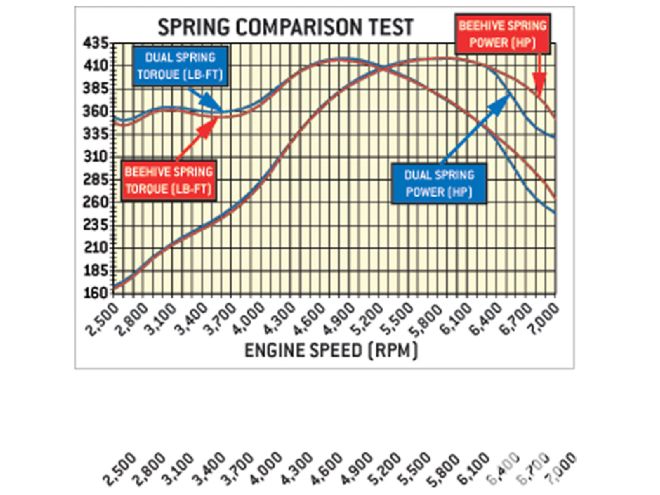
Overall peak output was virtually the same: 418.4 lb-ft for the 954 versus 416.9 lb-ft for the 26918, both at 4,800 rpm; and 418.2 hp versus 419.3 hp for the 954 and 26918, respectively, at 5,800 rpm. Average output throughout the 2,500- to 7,000-rpm test range varied by only about two numbers. But above 6,500 rpm, the difference was huge: The new-tech 26918 effectively extended the engine's rpm range, proving to be worth 15 to 36 hp and 12 to 28 lb-ft on top. The stiffer 954 did produce more low-end torque because its higher loads were actually bending the other components, effectively decreasing duration at the valve.
Calculating Spring Load Changes
What if you have to deviate from the catalog's published installed and open pressures? How do you recalculate spring loads if you want or need to run different spring heights? The math is easy for conventional constant-rate (same top and bottom diameter) springs. Let's walk through it: Suppose a particular spring's published specs are: 100 psi closed at a 2.0-inch installed height and 400 psi open at 1.0 inch. What would its closed and open pressures be if it were installed at 1.8 inches and its open pressure checkpoint was now 0.800 inch? This is where spring rate (in lb/in) comes into play. To determine spring rate absent published specs, subtract the original closed pressure from the open pressure, then divide the result by the distance between the original installed and open heights. In our previous example: [(400 - 100) ÷ (2 -1) = 300 lb/in.], multiplying the rate by the change in height yields the change in pressure: [300 × 0.2 = 60 psi]. In this case, since the heights are shorter, you would add the change to the published figures to establish the new pressures (in our example, 160 open/460 closed). If the new height is longer, subtract the change from the published figures. If the closed and open heights did not change by the same amount, solve each case separately. Getting a little more pressure out of your springs could delay valve float, as long as by reducing your heights you don't stray into coil bind.
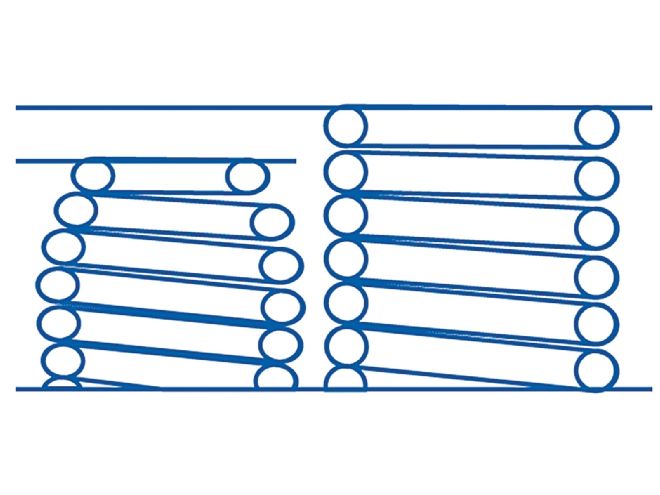
Coil Bind
In any spring installation, coil bind is to be avoided at all costs. If the coils stack solid or bind at or before full lift, at a minimum, the now-infinite load on the valvetrain will cause its weakest link to fail. If you're lucky, the result is merely a bent pushrod. If you're not, you're looking at a broken spring, a dropped valve, or worse.
When installed at the correct height to develop the right seat and open pressures for the application, the spring needs to have a safety margin before coil bind occurs. The simple formula used to determine whether a spring has sufficient coil bind clearance is: [valve-spring installed height on the seat - (cam lobe lift × rocker arm ratio) + valve lash - safety margin] gives you the remaining open spring length, which should be equal to or greater than the spring manufacturer's published coil bind height.
Thinking has evolved on how much safety margin is needed. About 0.060 inch used to be the textbook minimum, with more OK and even desirable. That's still an acceptable standard for everyday performance use, but Massingill says that in some cases "0.060 has become the maximum rather than the minimum." Godbold notes that "from high-speed video and testing, it is clear that adjacent coils contact as you approach the valvetrain limiting speed. Hence, modern springs are designed to run near coil bind and use the coil-to-coil interaction for improved damping at or near max lift. This interaction is one of the most effective means of dampening spring surge, but the valvespring must be properly designed in terms of solid stress to safely use this interaction." Depending on the intended use, the spring and cam-lobe design, and the engine builder's preferences, you will now see coil bind safety margins vary from as low as 0.015 inch to as high as 0.120 inch, with tighter numbers predominating on very stiff valvetrains. In a serious valvetrain, anything more than 0.150 inch can cause spring surge, which can greatly reduce the available spring load needed to close the valve.
Retainers and Locks
No valvespring discussion would be complete without touching on the gear that actually retains the spring on the valve stem: the retainers and locks (aka keys or keepers). A retainer must be the right diameter to fit the spring, and-in the case of dual or triple springs-the steps must be in the correct location to match each spring element. The actual fit should be snug but not excessively tight; Duttweiler likes to see about a 0.010-inch difference, while SAM calls for about a 0.005-inch interference fit: "Any more puts stress on the spring wire, leading to failure." Godbold concurs: "If the fit is too tight, more than a slight snap fit, there is added stress at the spring tip that can lead to failure. If the retainer is too loose, then there will be much more wear between the spring and retainer." On multiple springs, this applies to each individual spring comprising the assembly.
The retainer must also be compatible with the valve lock angle. For years, valve locks were machined at a 7-degree angle of incidence. Comp Cams developed (and patented) 10-degree locks, which have a larger contact area that spreads the load over a greater surface area. For most performance work, the 10-degree configuration has pretty much become the industry standard.
But there are still some 7-degree proponents. SAM's Massingill maintains that the 7-degree lock puts greater clamping force on the valve. "The step on the inside of the retainer only locates the retainer to set the correct installed height; it doesn't actually hold the retainer in place. This is done by the clamping force of the spring pressure; as pressure increases, so does the clamping force." The so-called Super 7 lock (which is actually 8 degrees) may be the best of both worlds: Available from Manley and others, it has almost as much surface area as a 10 but the clamping force of a 7.
While the lock's outer angle must mate with the retainer, its inside shape must match the valve stem diameter and be compatible with the shape of the valve stem's retention groove. Different valve stem sizes will require corresponding locks. As for shape, traditionally, most U.S. domestic valves were machined with square keeper grooves. Motorcycles, imports, many late-model domestics, and now high-end custom valves often use a superior radiused beadlock groove. Less likely to propagate stress cracks, the radiused groove has no sharp edges and a greater contact depth-but the machining process is more costly. Consider beadlock retention mandatory for small-diameter valve stems (less than 5/16 inch) or with any titanium valves; it's also a good idea with larger-stem stainless valves or more-than-200-pound seat pressures if you need to order custom valves anyway.
Titanium Parts
On engines routinely running more than 6,500 rpm, it's just as important to reduce the mass of the retainer. To a lesser extent-because they're pretty light to begin with-this also applies to the locks. "As you run closer to valve float, the lighter stuff will give you a little bit of insurance," Sherman says.
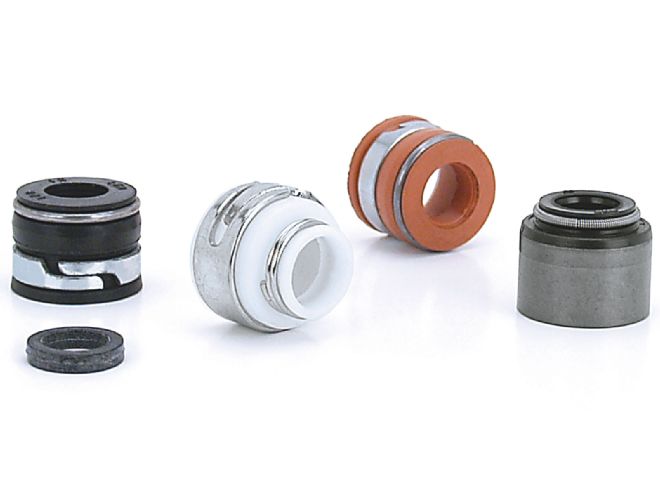 Street engines should run both intake and exhaust valve seals. Some racers don't run an exhaust seal because oil is needed for valve cooling (turbo engines are one example). Reduced-diameter, metal-body Viton or high-temp, molded-rubber-over-guide seals are preferred over old-school PC seals. The small-od seals are needed to clear triples and small-diameter double springs. Old-school heads may require valveguide machining to use them.
Street engines should run both intake and exhaust valve seals. Some racers don't run an exhaust seal because oil is needed for valve cooling (turbo engines are one example). Reduced-diameter, metal-body Viton or high-temp, molded-rubber-over-guide seals are preferred over old-school PC seals. The small-od seals are needed to clear triples and small-diameter double springs. Old-school heads may require valveguide machining to use them.
Premier lightweight parts are made from titanium (Ti). Many racers use Ti retainers; not so much Ti locks, except on the extreme high end. Ti retainers for a V-8 are about $200 more costly than equivalent steel parts. And instead of paying $25 to $30 for a good set of steel locks, you may end up forking over $225 to $230 for Ti units. And Massingill cautions, "We have found that Ti locks when used with Ti retainers need to be coated-very expensive."
Ti retainers shave 20 to 30 grams off equivalent mild steel parts. Sherman says on roller cams, Ti retainers "offer an additional 300-rpm cushion before valve float," while Duttweiler claims more than 500 rpm. Massingill adds that Ti retainers are "especially important as rpm and weight of the valves increase: for example, a big-block Chevy at 7,500 rpm with stainless valves." Although suitable for most high-rpm apps, "there's a wear issue with Ti in some endurance applications," Godbold cautions. "For many people, a tool steel retainer is a great compromise. These cost less than Ti but do not wear and only weigh about 2 grams more." Tool steel retainers are also thinner, gaining critical installed height in tight clearance situations.
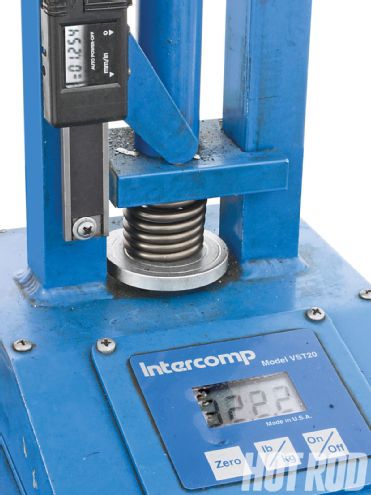 Don't take published spring coil bind height data as gospel. Measure for it using a feeler gauge and a ruler on the assembled engine or in a vise. Alternatively, check for coil bind and open and closed pressures with a spring tester. Sherman says, "Never trust the rocker arm ratio to give you the lift stated on the cam card. I've often seen it go much higher." Multielement springs must be checked using the correct corresponding retainer.
Don't take published spring coil bind height data as gospel. Measure for it using a feeler gauge and a ruler on the assembled engine or in a vise. Alternatively, check for coil bind and open and closed pressures with a spring tester. Sherman says, "Never trust the rocker arm ratio to give you the lift stated on the cam card. I've often seen it go much higher." Multielement springs must be checked using the correct corresponding retainer.
Ultimately, there are Ti valves. Besides their great cost (about $100 to $150 each), you also need to consider them relative to the total engine build. Sherman points out, "To maintain strength, a Ti valve's head needs to be twice as thick as steel, so there's about 0.060 inch less piston-to-valve clearance. You'll need a custom valve job to match the thicker heads, plus custom pistons with extra-deep valve reliefs. In my view, they're optional except for an extreme-envelope flat-tappet cam. I'd say if you need to shave weight, generally the Ti retainer is the most cost-effective solution."
All this points out the necessity of considering the engine a total, integrated package. The cam, springs, and other valvetrain parts must be selected to work as a team together, as well as complement the cylinder head characteristics, collectively yielding a performance operating envelope that produces the desired power output needed for the application without breaking the bank. Ultimately, everything affects everything else.